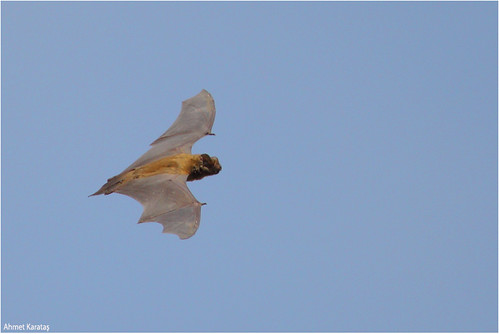Post by Deleted on Feb 17, 2016 22:15:26 GMT 5
Greater Noctule Bat - Nyctalus lasiopterus
The greater noctule bat (Nyctalus lasiopterus) is a rare bat found in Europe, West Asia, and North Africa. It is the largest and least studied bat in Europe with a wingspan of up to 46 centimeters and is one of the few bat species to feed on passerine birds. Greater noctule bats are the only bat species to hunt birds on the wing rather than when roosting. The Greater noctule bat employs echolocation, has wings adapted for open-air hunting, and has echolocation frequencies above the hearing range of birds. These characteristics of the greater noctule indicate that it is well adapted for hunting passerines in the air. The Greater Noctule is one of the largest bats with a wingspan of 41–46 cm (16–18 in). Its head-and-body length is from 8.4 to 10.4 cm (3.3 to 4.1 in), its tail is from 5.5 to 6.6 cm (2.2 to 2.6 in) and its forearm ranges from 6.2 to 6.8 cm (2.4 to 2.7 in). The body mass of adults ranges from 41 to 76 g (1.4 to 2.7 oz).

Great Grey Shrike - Lanius excubitor
The Great Grey Shrike, Northern Grey Shrike, or Northern Shrike (Lanius excubitor) is a large songbird species in the shrike family (Laniidae). It forms a superspecies with its parapatric southern relatives, the Southern Grey Shrike (L. meridionalis), the Chinese Grey Shrike (L. sphenocerus) and the Loggerhead Shrike (L. ludovicianus). Within the Great Grey Shrike species itself, there are nine subspecies. Males and females are similar in plumage, pearly grey above with a black eye-mask and white underparts. Breeding takes place generally north of 50° northern latitude in northern Europe and Asia (where it is known as the Great Grey Shrike), and in North America (where it is known as the Northern Shrike) north of 55° northern latitude in Canada and Alaska. Most populations migrate south in winter to temperate regions. The Great Grey Shrike is carnivorous, with rodents making up over half its diet. Size: 23-24 cm (9-9 in) , Wingspan: 30-35 cm (12-14 in), Weight: 56-79 g (1.98-2.79 ounces).

The greater noctule bat (Nyctalus lasiopterus) is a rare bat found in Europe, West Asia, and North Africa. It is the largest and least studied bat in Europe with a wingspan of up to 46 centimeters and is one of the few bat species to feed on passerine birds. Greater noctule bats are the only bat species to hunt birds on the wing rather than when roosting. The Greater noctule bat employs echolocation, has wings adapted for open-air hunting, and has echolocation frequencies above the hearing range of birds. These characteristics of the greater noctule indicate that it is well adapted for hunting passerines in the air. The Greater Noctule is one of the largest bats with a wingspan of 41–46 cm (16–18 in). Its head-and-body length is from 8.4 to 10.4 cm (3.3 to 4.1 in), its tail is from 5.5 to 6.6 cm (2.2 to 2.6 in) and its forearm ranges from 6.2 to 6.8 cm (2.4 to 2.7 in). The body mass of adults ranges from 41 to 76 g (1.4 to 2.7 oz).

Great Grey Shrike - Lanius excubitor
The Great Grey Shrike, Northern Grey Shrike, or Northern Shrike (Lanius excubitor) is a large songbird species in the shrike family (Laniidae). It forms a superspecies with its parapatric southern relatives, the Southern Grey Shrike (L. meridionalis), the Chinese Grey Shrike (L. sphenocerus) and the Loggerhead Shrike (L. ludovicianus). Within the Great Grey Shrike species itself, there are nine subspecies. Males and females are similar in plumage, pearly grey above with a black eye-mask and white underparts. Breeding takes place generally north of 50° northern latitude in northern Europe and Asia (where it is known as the Great Grey Shrike), and in North America (where it is known as the Northern Shrike) north of 55° northern latitude in Canada and Alaska. Most populations migrate south in winter to temperate regions. The Great Grey Shrike is carnivorous, with rodents making up over half its diet. Size: 23-24 cm (9-9 in) , Wingspan: 30-35 cm (12-14 in), Weight: 56-79 g (1.98-2.79 ounces).





